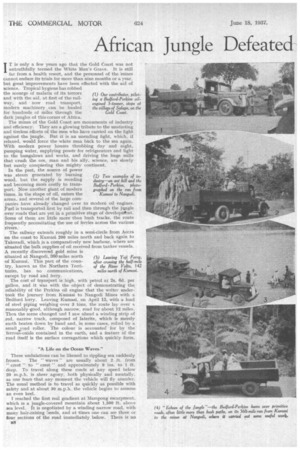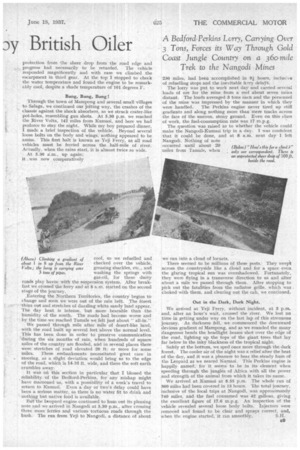African Jungle Defeated
Page 42

Page 43

If you've noticed an error in this article please click here to report it so we can fix it.
ay British Oiler A Bedford-Perkins Lorry, Carrying Over 3 Tons, Forces its Way Through Gold Coast Jungle Country on a 360-mile Trek to the Nangodi Mines IT is only a few years ago that the Gold Coast was not untruthfully termed the White Man's Grave. It is still far from a health resort, and the personnel of the mines cannot endure its trials for more than nine months or a year, but great improvements have been effected with the aid of science. Tropical hygiene has robbed the scourge of malaria of its terrors (1) 0117 contributor, pilot.. and with the aid, at first of the•railing a Bedford-Perkins oil way, and now road transport, engined 3-tonner, stops at modern machinery can be hauled the village of Salaga, on the for hundreds of miles through the Gold Coast.
dark jungles of this corner of Africa.
The mines of the Gold Coast are monuments of industry and efficiency. They are a glowing tribute to the unstinting and tireless efforts of the men who have carried on the fight against the jungle. But it is an unending fight, which, if relaxed, would force the white man back to the sea again. With modern power houses throbbing day and night, pumping water, supplying power for refrigerators and light to the bungalows and works, and driving the huge mills that crush the ore, man and his ally, science, are slowly but surely conquering this mighty continent.
In the past, the source of power
was steam generated by burning (2) Two examples of in wood, but the supply is receding dustry—em ant hill and the and becoming more costly to transBedford-Perkins, photo port. Now another giant of modern graphed on the run from times, in the shape of oil, enters the Kumasi to Nangodi. arena, and several of the large com
panies have already changed over to modern oil engines. Fuel is transported first by rail and then through the jungle over roads that are yet in a primitive stage of developntant. Some of them are little more than bush tracks, the route frequently necessitating the use of ferries across the various rivers; The railway extends roughly in a semi-circle from Accra on the coast to Kumasi 200 miles north and back again to Takoradi, which is a comparatively new harbour, where are situated the bulk supplies of oil received from tanker vessels. A recently discovered gold mine is
situated at Nangodi, 360 miles north (3) Leaving Yeji Ferry, of Kumasi. This part of the counafter crossing the half-mile try, known as the Northern Terriof the River Volta, 142 tories, has no communications, miles north of Kumasi. except by road and ferry.
The cost of transport is high, with petrol at 2s. 6d. per gallon, and it was with the object of demonstrating the reliability of the Perkins oil engine that the writer undertook the journey from. Kumasi to Nangodi Mines with a Bedford lorry. Leaving Kumasi, on April 13, with a load of steel piping weighing over 3 tons, the route lay over a reasonably-good, although narrow, road for about 12 miles. Then the scene changed and I saw ahead a winding strip of red, narrow track, composed of laterite, which is merely earth beaten down by hand and, in some cases, rol..ed by a small Joad roller. The colour is accounted for by the ferrous-oxide contained in the earth, and a feature of the road itself is the surface corrugations which quickly form.
"A Life on the Ocean Waves-" These undulations can be likened to rippling sea suddenly frozen. The " waves" are usually about 2 ft. from " crest " to " crest " and approximately 9 ins. to 1 ft. deep. To travel along these roads at any speed below 20 m.p.h. is sheer agony, both 'physically and mentally, as one fears that any moment the vehicle will fly asunder. The usual method is to travel as quickly as possible with safety and at about 30 m.p.h. the vehicle begins to assume an even keel.
I reached the first real gradient at Marnpong escarpment, which is a jungle-covered mountain about 1,500 ft. above sea level. It is negotiated by a winding narrow road, with many hair-raising ;sends, and at times one can see three or four sections of the road immediately below. There is no BS
protection from the sheer drop from the road edge and progress had necessarily to be retarded. The vehicle responded magnificently and with ease we climbed the escarpment in third gear. At the top I stopped to check the water temperature and found the engine to be remarkably cool, despite a shade temperature of 101 degrees F.
Bang, Bang, Bang!
Through the town of Mampong and several small villages to Salaga, we continued Our jolting way, the crashes of the chassis against the shock absorbers, as we struck crater-like pot-holes, resembling gun shots. At 5.30 p.m. we reached the River Volta, 142 miles from Kumasi, and here we had perforce to stay the night. While my boy prepared dinner, I made a brief inspection of the vehicle. Beyond several loose bolts on the body and wings, nothing appeared to be amiss. • This first halt is known as Yeji Ferry, as all road vehicles must be ferried across the half-mile of river. Actually, when the rains start, it is almost twice as wide.
At 5.39 a.m., up again; was now comparatively cool, so we refuelled and checked over the vehicle, greasing shackles, etc., and washing the springs with gas-oil, for these dusty roads play havot with the suspension system. After breakfast we crossed the ferry and at S a. m. started on the second stage of the journey.
,Entering the Northern Territories, the country begins to 'change and sobn we were out of the rain belt. The forest -thins out and stretches of dazzling white sandy land appear. The clay heat is intense, but more •bearable than the humidity of the south. The roads had become worse and by the time we reached Tamale we felt just about " all-in."
We passed through mile after mile of desett-like land, with the road built up several feet above the normal level. This has been done in order to preserve communication during the six months of rain, when hundreds of square miles of the country are flooded, and in several places there Were stretches of road elevated 20 ft. or more for some miles. These ernba.nkments necessitated great care in steering, as a slight deviation would bring us to the edge of the road, which is 14-16 ft. wide, and there the soft earth crumbles away.
It was on this section in particular that I blessed the reliability, of the Bedford-Perkins, for any mishap might have marooned us, with a possibility of a week's travel to return to Kumasi. Even a day or two's delay could have been a Serious, matter, as there is no water fit to drink and '• nothing but native food is available.
But the lieopard engine continued to hum out its pleasing note and we arrived in Nangodi at 5.30 p.m., after crossing three more ferries and various tortuous roads through the bush. The run from Yeti to Nangodi, a distance of about
(Above) Climbing a gradient of about 1 in 8 up from the River Volta ; the lorry is carrying omr 3 tons of pipes.
230 miles, had been accomplished in 91 hours, inclusive of refuelling stops and the inevitable ferry delays. • The lorry was put to work next day and carried several loads of ore for the mine from a reef about seven miles distant. The loads averaged 3 tons each and the personnel of the mine was impressed by the manner in which they were handled. The Perkins engine never tired up stiff gradients and along nothing more than 'mere tracks across the face of the uneven, stony ground. Even on this class of work, the fuel-consumption rate was 17 m.p.g.
The question was raised as to whether the vehicle could make the Nangodi-Kumasi trip in a day. I was confident that it could be done, and at 8 a.m. next day I left Nangodi. Nothing of note miles from Tamale, when occurred until about 20 we ran into a cloud of locusts.
There seemed to he millions of these pests. They swept across the countryside like a cloud and for a space even the glaring tropical sun was overshadowed. Fortunately, they were flying in a transverse direction to us and after about a mile we passed through them. After stopping to pick out the fatalities from the radiator grille, which was . choked with them, and clearing out the cab, we continued.
Out in -the Dark, Dark Night.
We arrived at Yeji. Ferry, without incident, at 3 p.m. and, after an hour's wait, crossed the river. We lost no time in getting under way on the last lap of this strenuous journey. As darkness fell, we commenced the downward devious gradient of Mampong, and as we rounded the ninny dangerous bends the headlight beams-shot over the edge of the road, lighting up the tops of the giant trees that lay far below in the inky blackness of the tropical night.
. Safely at the bottom, we sped once more through the dark forest. The cooler air of the night was a relief after the heat of the day, and it was a pleasure to hear the steady hum of the Leopaid as we neared Kumasi. This Perkins engine is happily named, for it seems' to he in its clement when speeding through the jungles of Africa with all the power and strength of the animal from which it takes its name.
We arrived at Kumasi at 8.55 p.m. The whole run of 380 miles had been covered in 13 hours. The total journey, inclusive of the local trips at Nangodi, was approximately 740 miles, and the fuel consumed was 42 gallons, giving the excellent figure of 17.6 m.p.g. An inspection of the vehicle revealed several loose body bolts. Injectors were removed and found to be clear and sprays correct, and when the engine started, it ran smoothly. S.H.




























































































